Asaklitt 31-8542 User Manual [de]

Svenska English
Norsk
Suomi
Deutsch
20″ Bicycle
Cykel 20 ″
Sykkel 20 ″
Polkupyörä 20 ″
Fahrrad 20 ″
Art.no.
31-8542
20150422 .Ver

English
20″ Bicycle
Art.no 31-8542
Please read the entire instruction manual before using the product and then save it for future reference. We reserve the right for any errors in text or images and any necessary changes made to technical data. If you have any questions concerning technical problems please contact our Customer Services.
Contents |
|
1. Safety......................................................................................................... |
3 |
2. Product description.......................................................................... |
4 |
3. Assembly............................................................................................... |
6 |
4. Adjusting................................................................................................. |
7 |
4.1 Checking/adjusting handlebar height and angle.................................................... |
7 |
4.2 Checking/adjusting saddle height and angle......................................................... |
8 |
5 Checking/adjusting the brakes.................................................. |
8 |
5.1 Front and rear rim brakes................................................................................................... |
8 |
5.2 Coaster brake............................................................................................................................ |
9 |
5.3 Checking for rim wear.......................................................................................................... |
9 |
6. Checking/adjusting the gears................................................... |
9 |
7. Checking/adjusting chain tension.......................................... |
10 |
8. Attaching/removing the wheels ............................................ |
10 |
8.1 Wheel alignment....................................................................................................................... |
11 |
9. Care and maintenance................................................................... |
11 |
9.1 Winter storage............................................................................................................................ |
11 |
10. Disposal................................................................................................. |
11 |
11. Specifications..................................................................................... |
12 |
2

1. Safety
• This bicycle is designed to be ridden on normal roads and not for terrain or competitive use. |
English |
|
Any form of use other than that described in this instruction manual can lead to a serious risk |
||
|
||
for personal injury or damage to the bicycle itself. |
|
|
• Preparations before use: Setting the correct saddle and handlebar height. Become familiar |
|
|
with how the brakes operate and identify which brake handle operates the front brake |
|
|
and which operates the rear. This bicycle is even equipped with a coaster brake which is |
|
|
activated when either of the pedals are pushed in a backwards direction. Make it a habit of |
|
|
testing the brakes regularly. Test the different braking systems in an appropriate area before |
|
|
embarking on a ride. Select an area free of traffic or other road hinders. Never brake hard |
|
|
using the coaster brake in slippery conditions, e.g. on gravel, ice, snow or wet tarmac. For |
|
|
steep hills several braking methods should be combined, otherwise using the coaster brake |
|
|
alone may cause it to overheat. |
|
|
• Make sure that the seat and handlebar post are set within their recommended limits. |
|
|
The posts may not be extended outside or fall short of these recommended limits. |
|
|
-- A) The handlebar post has a max extension marking: MIN INSERTION, this marking |
|
|
indicates that the handlebar post is at its maximum safe extension point, and shows |
|
|
the minimum portion that must be inserted into the bicycle’s steering column for safe |
|
|
operation. |
|
|
-- B) The seat post has two markings: ↑ MINIMUM INSERT ↑ shows the position at which |
|
|
the seat post is at its maximum extension point and ↓ MAXIMUM ↓ the minimum portion |
|
|
that must be slotted into the frame. |
|
|
• Recommendations for safe bicycle use – Use a bicycle helmet, check brakes regularly and |
|
|
examine them for wear. Check that all brake components are securely fastened. Check tyres, |
|
|
wheels and handlebars for wear and performance. |
|
|
• Remember that braking distance is substantially increased on ice, snow and wet tarmac. |
|
|
Make sure before every use that the cycle’s quick releases for the handlebars, handlebar post |
|
|
and seat post are securely locked along with testing that the handlebar assembly and frame |
|
|
lock levers work properly. |
|
|
• Max bicycle load: Max total weight 119 kg (bicycle + rider+ packing). |
|
|
• Max bike rack load: 15 kg. |
|
|
• Max rider weight: 90 kg. |
|
|
• Remember that rules and regulations for bicycles will differ from country to country. This may |
|
|
include regulation regarding front, rear and side reflectors along with front and rear lights. |
|
|
Familiarise yourself with the rules and regulations that apply in your country. |
|
|
• Tighten all nuts, bolts and screws but do not overtighten. (See section 2. Product description). |
|
|
• Adjust the bicycle so that it fits you. There are quick releases for the handlebars, handlebar |
|
|
post and seat post, which makes adjustments easy. |
|
|
• Always conduct a safety check before riding. |
|
|
• Always use a properly adjusted and fitted helmet. |
|
|
• Always keep both hands on the handlebars. |
|
|
• Always ride in the same direction as traffic flow. Never ride against traffic. |
|
|
• Always follow the Highway Code. |
|
|
• Wear clothing that makes you visible to your fellow road users. |
|
|
• The bicycle must be equipped with wheel reflectors, both front and back and pedal |
|
|
reflectors. Make sure that all reflectors are clean and visible. |
|
|
• When riding in darkness make sure that you have properly functioning lights, both front and rear. |
|
|
• Warning: Always brake using the rear brakes first before attempting to use the front brakes. |
|
|
This especially applies if road surfaces are slippery. |
|
3
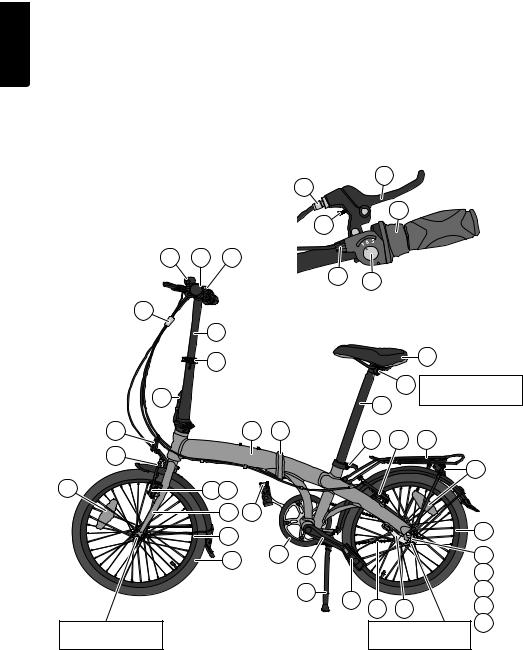
English
•Never use loose fitting clothing or similar apparel that can get caught in the bicycle’s chain or wheels.
•Show consideration when riding in traffic. Don’t ride close to pedestrians, horse riders or the disabled.
Warning: This bicycle is not designed to be used with bicycle child seats or similar.
Warning: As with all mechanical components, the bicycle is subjected to wear and high stresses. Different materials and components may react to wear or stress fatigue in different ways. If the design life of a component has been exceeded, it may suddenly fail possibly causing injuries to the rider. Any form of crack, scratches or change of colouring in highly stressed areas indicate that the life of the component has been reached and it should be replaced.
2. Product description
2 |
1 |
9 |
10 |
11
6 |
8 |
3 |
7 |
5 |
4 |
|
14 |
15 |
14 |
12 |
13 |
|
21 |
22 |
16 17 |
18 |
19 |
20 |
14 
26 |
23 |
|
27 |
Tightening front wheel 30–35 Nm
29 |
30 |
Tightening |
28 |
saddle10 Nm |
|
31 |
32 |
33 |
14 |
34 |
|
|
|
35 |
|
|
|
37 |
24 |
|
|
38 |
25 |
36 |
39 |
|
|
Tightening rear |
40 |
|
|
|
||
|
wheel 35–40 Nm |
|
|
4

1.Handlebar
2.Bicycle bell
3.Gear shifter
4.Gear indicator
5.Gear shifter wire adjustment barrel
6.Brake lever (one on each side)
7.Brake lever adjustment screw
8.Brake wire adjustment barrel
9.Handlebar quick release
10.Wires (3 x)
11.Handlebar post
12.Handlebar post quick release
13.Handlebar assembly lock lever with catch
14.Reflectors (front, rear, wheels and pedals)
15.Front rim brakes
16.Spring tension adjustment screw
17.Brake pads
18.Front fork
19.Front wheel
20.Tyre
21.Frame
22.Bicycle frame lock lever with catch
23.Crankset
24.Pedal
25.Bicycle Chain
26.Chain guard
27.Kickstand
28.Seat post
29.Saddle
30.Saddle clamp bolt
31.Seat post quick release
32.Rear rim brakes
33.Bike rack
34.Rear wheel
35.Rear coaster brake hub
36.Rear coaster brake arm
37.Bellcrank
38.Bellcrank locking screw
39.Bellcrank adjustment barrel
40.Gear adjustment window
English
5
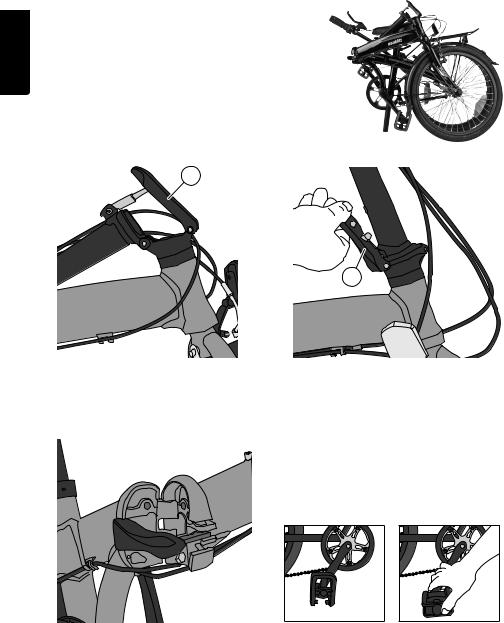
English
3. Assembly
The bicycle comes fully assembled but in collapsed form.
Unfolding the bike:
13 |
13
Extend the handlebar assembly. |
Press the lock lever (13) upwards towards |
|
the handlebar post. Make sure the lock |
|
lever’s catch has engaged into its locked |
|
position. Check that the catch holds the lock |
|
lever in position so the lever can’t be moved |
|
unless the catch is pressed in. |
Unfold the frame. |
Grip the pedals and unfold them. |
6
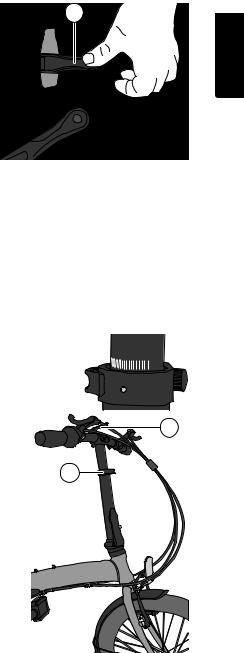
Press the lock lever (22) forwards to lock the frame. |
22 |
|
Make sure the lock lever’s catch has engaged into |
||
|
||
its locked position. Check that the catch holds |
|
|
the lock lever in position so the lever can’t be |
|
|
moved unless the catch is pressed in. |
|
4. Adjusting
4.1 Checking/adjusting handlebar height and angle
Adjust the handlebar height and angle to fit you. Pull the handlebar and seat post up to a level that feels right for you. Sit on the saddle, check for a comfortable height and ensure that your feet can touch the ground on your tiptoes.
Warning: The handlebars and handlebar post quick release must not be adjusted while riding. All adjustments must be made while the bicycle is standing still.
The handlebar post (11) has a quick release (12) for quick and easy handlebar height adjustment. There is also a handlebar quick release (9) for adjusting the handlebar angle.
The handlebar post has an important max extension marking that should be observed: MIN INSERTION, this marking indicates that the handlebar post is at its maximum safe extension point, and shows the minimum portion that must be inserted into the bicycle’s steering column for safe operation. Note: The IIIIIIIIIIIIIIIIIII markings on the seat post should be clearly visible above the seat post frame.
The handlebar height should be adjusted so that the rider is in a comfortable and commanding position while riding. Adjust the handlebar’s steering angle as needed. Open the quick release (9) and adjust. Make sure that all steering components are in proper working order after adjustment.
Remember to lock all quick-releases before riding!
9 |
12 |
English
7

English
4.2 Checking/adjusting saddle height and angle
Loosen the seat post quick-release (30) to adjust.
Note: The seat post has two markings:
↑ MINIMUM INSERT ↑ shows the position at which the seat post is at its maximum extension point and
↓ MAXIMUM ↓ the minimum portion that must be slotted into the frame. Note: The IIIIIIIIIIIIIIIIIII markings on
the seat post should be clearly visible above the seat post frame.
The saddle height should be adjusted so that your foot, with your leg almost completely extended, can be placed flat onto the pedal at the bottom of the pedal stroke. You should also be able to touch the ground with your tiptoes if needed.
The saddle (29) should be positioned completely horizontal or tilted slightly backwards. Finding
a comfortable saddle angle is dependent on your personal tastes. It may require a long bike ride for you to find a position that is most comfortable for you.
Adjust the saddle angle by loosening the saddle clamp bolt (30). Adjust the angle by tilting the saddle forwards or backwards.
Remember to re-tighten all screws and nuts before riding! |
30 |
|
Warning: Always make sure that the lock levers, both for the frame (22) and handlebar assembly (13) are securely locked and that their catches hold and operate properly!
5 Checking/adjusting the brakes
5.1 Front and rear rim brakes
Check that both rims are whole and free from grease or oil.
Regular brake checking procedure: Pull the brake handles and make sure that the brake lines are whole, that both brake pads make contact with the rims simultaneously and that the brake handles cannot be pulled so far that they bottom out onto the handlebars.
Adjust the rim brakes as necessary.
•Adjust the brake pads (17) to ensure that they are
aligned with the rims and do not come into contact |
|
with the tyres during braking. |
8 |
• The distance between the brake pads and the rims |
|
should be about 1–2 mm. Adjust this distance |
|
using the brake wire adjustment barrel (8) at |
|
the handlebars. |
|
8

•Adjust the brake position using the spring tension
screws (16) so that each brake pad makes contact with the rims simultaneously.
• Change brake pads when necessary using the same type of brake pads as the bike was originally equipped with. Brake pads should be positioned (toe-in) angled inwards with the brake pad’s leading edges approximately 1 mm from the rim. The brake pads have spherical washers for adjustment purposes.
16
5.2 Coaster brake
The coaster brake cannot be adjusted. Warning: Make sure that the brake arm (36) is securely fastened, otherwise it will not function properly. This can cause the rear wheel to lock and increase the risk for personal injury.
5.3 Checking for rim wear
The effectiveness of your brakes also depends on the condition of your rims. These must be checked regularly for wear. Good rims are an important safety
feature. The sides of your rims come under strain during braking and may eventually develop cracks. Because of this your rims are equipped with wear indicators. These are in the form of grooves etched onto the side of the rims where the brake pads make contact.
These grooves must remain visible. The wheels need to be replaced once these grooves can no longer be seen.
Warning: If worn rims are not replaced, they make cause the wheels to lock during braking which can greatly increase the risk for personal injury.
6. Checking/adjusting the gears
Set the shifter (3) in second gear. |
|
Make sure the gear indicator is between the window’s |
|
(40) indicator lines. If not; adjust with the bellcrank |
|
adjustment barrel (39) and then tighten the lock nut |
|
behind the barrel after adjustment. |
SET |
|
SET |
40 |
English
9

English
7. Checking/adjusting chain tension
Free play from the chain’s midpoint should not exceed 20 mm. The chain will be stretched during use.
Make sure that chain tension is regularly checked and adjusted to maintain optimum chain tension.
8. Attaching/removing the wheels
If a wheel needs to be removed, e.g. when a tyre is flat, remove the brake wire’s metal guide from its bracket in order for the tyre to lift out freely.
• Front wheel change: Screw in the adjustment barrel
(8) on the hand brake as far as it can go. Pinch the two brake arms together to remove the guide from its bracket. Spread the brake arms apart.
• Rear wheel change: Screw |
|
|
in the adjustment barrel (8) |
|
|
on the hand brake as far |
|
|
as it can go. Pinch the two |
|
|
brake arms together to |
39 |
|
remove the guide from |
||
its bracket. Remove the |
37 |
|
bellcrank (37). Use a 10 mm |
38 |
|
spanner (see fig) and |
||
|
||
loosen the bellcrank |
|
|
locking screw (38) and |
|
|
move the bellcrank to |
|
|
the side. |
|
Refit all the disassembled parts in reverse order. Remember to screw the adjustment barrel (8) on the hand brake back out again and adjust the rear brakes for proper functioning after mounting the rear wheel, see the Checking/adjusting the gears section. Check wheel alignment, see
the Wheel alignment section. Ensure that re-assembly was done correctly and check that the brakes are functioning properly before riding.
10

8.1 Wheel alignment
If you tighten the chain after replacing the rear wheel, make sure that both the front and rear wheels are aligned with each other after assembly. Checking alignment: From the front of the bike, point the handlebars straight and using your line of sight, check that the front and rear tyres line up. Otherwise use a straight board butted up against the tyres to check for alignment. If the wheels are out of alignment with each other it will be hard to steer and control the bike.
Ensure that re-assembly was done correctly and check that the brakes are functioning properly before riding.
9. Care and maintenance
•Clean your bicycle regularly. Use warm water and a brush or sponge for cleaning. Try to avoid using a high pressure washer for cleaning as the water jets may penetrate the ball bearing housing and shorten the life of your bike.
•Regularly check that all screws and nuts are securely tightened. See 2. Product description.
•Clean the chain with a brush and dry with a cloth.
•It is important that the chain, gears, wires and other moving parts are well lubricated with proper lubrication.
•Note: Make sure that the chain is correctly tensioned. Free play from the chain’s midpoint should not exceed 20 mm.
•Regularly check for brake wear and proper operation.
•Replace the brake pads when worn. If the brake pads are not completely worn, adjust the brake wire to improve braking performance.
•If your brakes don’t grip properly, it may be that the handlebar post or handlebars are loose or that your wheels are warped - leave your bike in for service at any Clas Ohlson Store or call Clas Ohlson’s Customer Services for assistance.
•Check both front and back lights and that all reflectors are whole and clean.
•Inflate tyres to their recommended pressure as marked on your tyre’s sidewalls.
•Make sure that no sharp stones and similar objects are caught in your tyres and that there is no other visible damage.
•Store your cycle in a sheltered environment. This will prolong the life of your cycle considerably.
9.1 Winter storage
•If you need to store your bicycle for any longer period, such as in winter, it should be stored in a dry frost-free environment.
•Make sure that your tyres are properly inflated.
•Remove any batteries from your lights, otherwise there is a risk that they can leak and cause damage.
•Make sure to wipe your rims when taking your bike out of storage as these can collect dust and interfere with the proper functioning of your brakes.
10. Disposal
This product should be disposed of in accordance with local regulations. If you are unsure how to proceed, contact your local council.
English
11
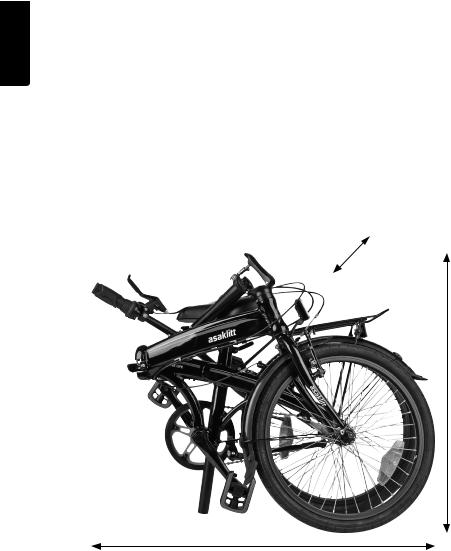
English
11. Specifications
Approx weight |
14 kg |
Saddle height |
Max 99 cm (depending on tilt angle) |
|
Min height approx 72 cm |
Handlebar height |
Max 105 cm (depending on tilt angle) |
|
Min height approx 91 cm |
Approx folded size |
95 × 65 × 37 cm (w × h × d) |
This bicycle meets European safety standard EN14764: 2005.
37 cm
65 cm
95 cm
12

Svenska
Cykel 20″
Art.nr 31-8542
Läs igenom hela bruksanvisningen före användning och spara den sedan för framtida bruk. Vi reserverar oss för ev. textoch bildfel samt ändringar av tekniska data.
Vid tekniska problem eller andra frågor, kontakta vår kundtjänst.
Innehållsförteckning |
|
1. Säkerhet ................................................................................................ |
15 |
2. Produktbeskrivning........................................................................ |
16 |
3. Montering............................................................................................. |
18 |
4. Justering............................................................................................... |
19 |
4.1 Kontrollera/justera styrets höjd och lutning........................................................... |
19 |
4.2 Kontrollera/justera sadelns höjd och lutning...................................................... |
20 |
5. Kontrollera/justera bromsarna.............................................. |
20 |
5.1 Fälgbromsar fram/bak........................................................................................................ |
20 |
5.2 Navbroms.................................................................................................................................... |
21 |
5.3 Kontrollera fälgarnas slitage........................................................................................... |
21 |
6. Kontrollera/justera växel............................................................ |
21 |
7. Kontrollera/justera kedjespänning...................................... |
22 |
8. Montering/demontering av hjul .......................................... |
22 |
8.1 Hjulinställning.......................................................................................................................... |
23 |
9. Skötsel och underhåll................................................................. |
23 |
9.1 Vinterförvaring av cykeln.................................................................................................. |
23 |
10. Avfallshantering............................................................................ |
23 |
11. Specifikationer................................................................................. |
24 |
14

1. Säkerhet
• Cykeln är avsedd för användning på normala vägar, den är inte avsedd för körning i terräng eller för användning i någon form av tävlingsverksamhet. Användning på annat sätt än vad som beskrivs här kan medföra risk för personskada eller skada på cykeln.
• Förberedelser innan användning: Ställ in rätt höjd för sadel och styre. Bekanta dig med
bromsarna, lär dig vilket bromshandtag som är för bakre resp. främre broms. Cykeln är även |
|
|
utrustad med en fotbroms som aktiveras när tramporna trycks bakåt. Ta för vana att alltid |
|
|
prova bromsförmågan med de olika bromssystemen på ett lämpligt ställe när du påbörjar |
|
|
en cykeltur, välj en plats utan trafik eller andra hinder. Bromsa aldrig hårt med frambromsen |
Svenska |
|
vid halt väglag, t.ex. på is och snö eller på regnvåt asfalt. I kraftiga nedförsbackar ska flera |
||
|
||
bromssystem användas, annars kan navbromsen i bakhjulet överhettas. |
|
|
• Kontrollera att sadelstolpen och styrstammen är inställda inom rekommenderad höjd. |
|
|
De får inte vara utdragna för mycket eller för lite. |
|
|
-- A) Styrstammen har en märkning: MIN INSERTION vid det läge där styrstammen får |
|
|
vara när den är som mest utdragen. |
|
|
-- B) Sadelstolpen har två märkningar: ↑ MINIMUM INSERT ↑ vid det läge där sadelstolpen |
|
|
får vara när den är som mest utdragen och ↓ MAXIMUM ↓ vid det läge där den får vara |
|
|
när den är som mest inskjuten. |
|
|
• Rekommendationer för säker användning av cykeln – Använd cykelhjälm, kontrollera regelbundet |
|
|
bromsarnas funktion och slitage samt att bromsarmen sitter fast. Kontrollera också funktion |
|
|
och slitage på däck, fälgar och styrning. |
|
|
• Tänk på att bromssträckan kan bli mycket längre på is, snö och regnvåt asfalt. Kontrollera |
|
|
alltid innan varje användningstillfälle att cykelns snabbjusteringar för styre, styrstam och |
|
|
sadelstolpe är i låst läge och att säkerhetsspärrarna för fällning av styrstam och vikning av |
|
|
ram fungerar på rätt sätt. |
|
|
• Maxbelastning för cykel: Max totalvikt 119 kg (cykel + användare+ bagage). |
|
|
• Maxbelastning för pakethållare 15 kg. |
|
|
• Maxbelastning för användare 90 kg. |
|
|
• Tänk på att regler och förordningar för cyklar kan vara olika i olika länder, det kan krävas |
|
|
reflexer framåt, bakåt och åt sidorna samt belysning framåt och bakåt. Ta reda på vad som |
|
|
gäller i ditt land. |
|
|
• Dra åt skruvar och muttrar så att de sitter säkert, men överdra inte (se 2. Produktbeskrivning). |
|
|
• Ställ in cykeln så att den passar dig. Cykeln har snabbjusteringar för styre, styrstam och |
|
|
sadelstolpe som gör att det är enkelt att justera så att den passar användaren. |
|
|
• Gör alltid en säkerhetscheck innan användning. |
|
|
• Använd alltid hjälm, hjälmen ska vara hel och rätt justerad. |
|
|
• Håll alltid båda händerna på styret. |
|
|
• Åk alltid i samma riktning som den övriga trafiken, åk aldrig mot trafiken. |
|
|
• Följ alltid gällande trafikregler. |
|
|
• Tänk på att använda kläder som gör att du syns av övriga trafikanter. |
|
|
• Cykeln måste vara försedd med reflexer i hjulen, fram och bak samt på pedalerna. Se till att |
|
|
cykelns reflexer är rena och väl synliga. |
|
|
• Vid färd i mörker måste cykeln ha fungerande belysning både fram och bak. |
|
|
• Varning! Bromsa alltid först med bakhjulsbromsen innan du bromsar med framhjulsbromsen, |
|
|
detta gäller speciellt om körbanan är hal. |
|
|
• Använd inte löst hängande kläder eller liknande som kan fastna i kedjan eller i hjulen när du cyklar. |
|
|
• Visa hänsyn i trafiken, åk inte för nära fotgängare, ryttare eller handikappade. |
|
15
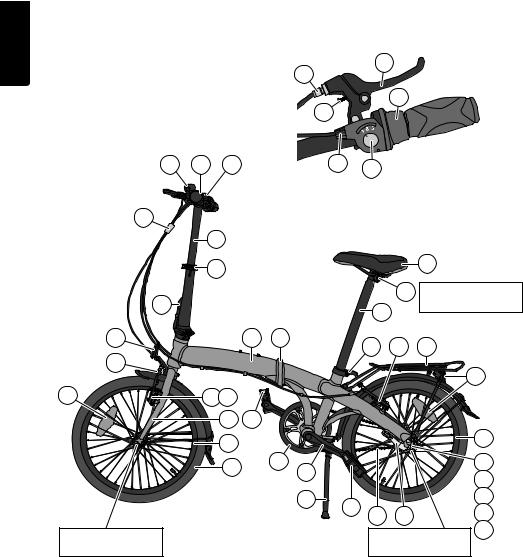
Svenska
Varning! Cykeln är inte avsedd för att användas med barnstol eller liknande.
Varning! Som alla mekaniska komponenter, är cykeln utsatt för slitage och stora påfrestningar. Olika material och olika komponenter kan reagera för slitage och materialutmattning på olika sätt. Alla komponenter har en viss livslängd och om livslängden överskrids, kan en komponent plötsligt sluta fungera och därmed medföra risk för personskada för användaren. Alla former av sprickor, repor eller färgändring i särskilt utsatta komponenter kan påvisa att komponentens maximala livslängd har nåtts och att den därmed ska bytas ut.
2. Produktbeskrivning
2 |
1 |
9 |
10 |
11
6 |
8 |
3 |
7 |
5 |
4 |
|
12 |
|
13 |
|
14 |
21 |
22 |
15 |
|
|
14 |
16 17 |
|
|
|
18 |
14 |
|
|
19 |
|
|
|
20 |
26 |
23 |
|
|
||
|
|
|
|
|
|
|
27 |
Åtdragningsmoment |
|
|
|
framhjul 30–35 Nm |
|
|
|
29 |
30 |
Åtdragningsmoment |
28 |
sadel 10 Nm |
|
31 |
32 |
33 |
14 |
34 |
|
|
|
35 |
|
|
|
37 |
24 |
|
|
38 |
25 |
36 |
39 |
|
|
Åtdragningsmoment |
40 |
|
|
bakhjul 35–40 Nm |
|
|
16

1.Styre
2.Ringklocka
3.Växelreglage
4.Växelindikator
5.Justerskruv för växelvajer
6.Bromshandtag (ett på varje styre)
7.Handtagsjustering
8.Justerskruv för bromsvajer
9.Snabbjustering av styrets lutning
10.Vajrar (3 st.)
11.Styrstam
12.Snabbjustering av styrstammens höjd
13.Snabbkoppling med spärr för vikning av styrstam
14.Reflexer (fram, bak, hjulen och pedalerna)
15.Främre fälgbroms
16.Justerskruv för fjäderspänning till bromsarm
17.Bromsbelägg
18.Framgaffel
19.Framhjul
20.Däck
21.Ram
22.Snabbkoppling med spärr för vikning av ram
23.Vevarm
24.Pedal
25.Kedja
26.Kedjeskydd
27.Stöd
28.Sadelstolpe
29.Sadel
30.Sadelns klämbult
31.Snabbjustering av sadelstolpens höjd
32.Bakre fälgbroms
33.Pakethållare
34.Bakhjul
35.Nav med navbroms
36.Navbromsens bromsarm
37.Växel
38.Låsskruv för växel
39.Justerskruv för växel
40.Fönster för växeljustering
Svenska
17

3. Montering
Cykeln kommer färdigmonterad men hopvikt.
Svenska
Vik upp cykeln så här:
13 |
13
Vik upp styrstammen. |
Tryck snabbkopplingen (13) uppåt så att den |
|
låser fast styrstammen. Kontrollera att snabb- |
|
kopplingens spärr har gått i lås. Kontrollera |
|
att spärren håller i så att det inte går att öppna |
|
snabbkopplingen utan att hålla in spärren. |
Vik ut ramen. |
Ta tag i pedalerna och vik ut dem. |
18
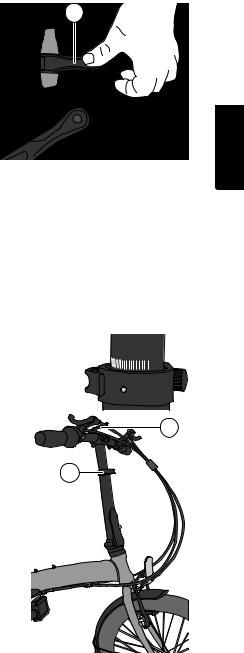
Tryck snabbkopplingen (22) framåt så att den låser ihop ramen. Kontrollera att snabbkopplingens spärr har gått i lås. Kontrollera att spärren håller i så att det inte går att öppna snabbkopplingen utan att hålla in spärren.
4. Justering
22 |
Svenska
4.1 Kontrollera/justera styrets höjd och lutning
Styrets höjd och lutning kan justeras så att det passar användaren. Dra upp styrstammen och sadelstolpen till en höjd som du tror är lagom. Sätt dig på sadeln och känn efter om höjden är rätt så att du når ner till marken.
Varning! Snabbjusteringen för styrstammens höjd (eller vikning) får inte röras under pågående cykling, all justering måste ske stillastående.
Styrstammen (11) har en snabbjustering (12) som gör det enkelt att ställa in styrets höjd. Den har också en snabbjustering (9) för styrets lutning.
Styrstammen har en viktig märkning: MIN INSERTION vid det läge där styrstammen får vara när den är som mest utdragen. Obs! Markeringen IIIIIIIIIIIIIIIIIII ovanför texten på sadelstolpen ska synas ovanför ramröret.
Styrets höjd ska ställas in så att användaren har en bekväm ställning vid cykling. Justera styrets lutning vid behov; öppna snabbjusteringen (9) och ställ in önskad lutning. Kontrollera att alla reglage på styret fungerar efter inställning.
Kom ihåg att låsa alla snabbjusteringar innan du börjar cykla!
9 |
12 |
19
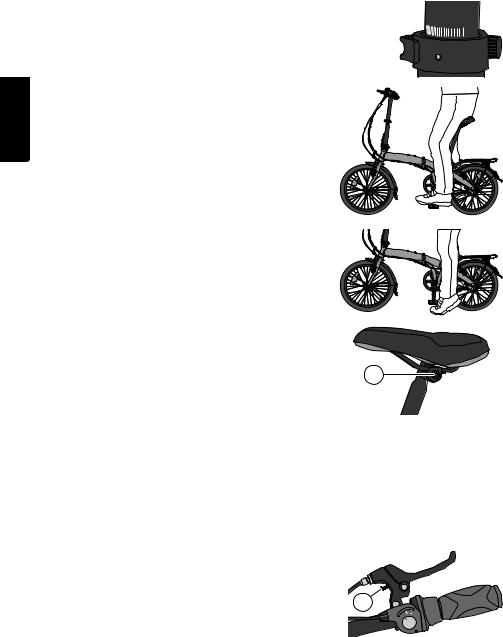
Svenska
4.2 Kontrollera/justera sadelns höjd och lutning
Höjdjusteringen kan göras efter att snabbjusteringen (30) har lossats.
Obs! Sadelstolpen har två märkningar:
↑ MINIMUM INSERT ↑ vid det läge där sadelstolpen får vara när den är som mest utdragen och ↓ MAXIMUM ↓ vid det läge där den får vara när den är som mest inskjuten. Obs! Markeringen IIIIIIIIIIIIIIIIIII ovanför texten på sadel stolpen ska synas ovanför ramröret.
Sadelhöjden ska ställas in så att foten, med benet nästan helt utsträckt, kan sättas ned mitt på pedalen när den är i nedersta pedalläget. Då ska man dessutom kunna röra vid marken med tårna.
Sadeln (29) ska ställas in horisontellt eller eventuellt så att den lutar något bakåt. Önskad lutning på sadeln är individuellt, och det kan krävas en lång cykeltur för att hitta den bekvämaste sittställningen.
Lutningen på sadeln kan ändras efter att sadelns klämbult (30) har lossats. Justera sadeln framåt eller bakåt.
Kom ihåg att dra åt alla skruvar som lossats för inställningen, |
|
innan du börjar cykla! |
30 |
|
Varning! Kontrollera alltid innan varje användningstillfälle att snabbkopplingarna för vikning av ram (22) och styrstam (13) är låsta och att spärrarna fungerar!
5. Kontrollera/justera bromsarna
5.1 Fälgbromsar fram/bak
Kontrollera att fälgsidorna är hela och rena och fria från fett.
Kontrollera fälgbromsarna regelbundet så här: dra in bromshandtaget och kontrollera att vajerns ytterhölje är helt, att båda bromsbeläggen går emot fälgkanten samtidigt och att inte bromshandtaget går att dra ända in mot handtaget.
Justera fälgbromsarna vid behov.
•Justera bromsbeläggen (17) så att de endast ligger
an mot fälgen och inte mot däcket på något sätt |
|
vid bromsning. |
8 |
• Avståndet mellan bromsbeläggen och fälgsidan bör |
|
vara 1–2 mm, justera avståndet med justerskruven (8) |
|
vid handtaget. |
|
20
